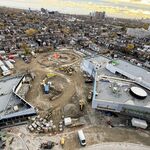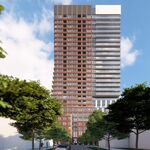felix123
Active Member
By far the largest? Currently they have 64 stations in Montreal and 4 more in surrounding regions. Once the new light rail in Montreal opens in 4 years, there'll be 8 new stops in Montreal on the Deux-Montagnes branch, 2 on the South-shore Branch, 2 on the Airport branch, and 4 on the Sainte-Anne-de-Bellevue branch along with 3 outside of Montreal on the south shore and 4 on Laval and the north shore. That brings the total number to 80 in Montreal and 11 more in surrounding areas, bringing the total to 91.
Toronto currently has 73 in the city and 2 north of the city. In 2 years another 21 open on Line 5 (all in the city) and in 2023 Line 6 opens with 17 additional stops (all in the city) bringing the total to 111 in the city and a total of 113. Meanwhile, outside the city, the Hurontario light rail is currently scheduled to open in 2022 (though will surely slip still) with another 19 stops. Subway expansions in the 2020s on Line 1 and the Ontario Line could add another 16 stations based on current plans.
Montreal may have more kilometres of track, because of the very long distance between stations - but with fewer new stops, I don't think you can say "by far the largest" RT system with only 80 planned by 2023 compared to 111 in Toronto. And only 91 planned including nearby communities compared to 131 in/around Toronto.
There's also the 33 stops on the light rail in Hamilton and Kitchener - though that's probably unfair to include, as they won't be connected by every-15 minute commuter rail service to the rest of the region for many years, unlike Hurontario.
And of course all that ignores that GO is moving to every 15-minute RER service on parts of at least 5 lines, with Lakeshore East already running every 15 minutes for part of the day, and Lakeshore West currently on a (bizarre) 15-15-30 schedule. I'm not aware of where RTM's plans to increase Exo service are at ... if anything I'd think service will be decreasing with plans to close 1 of the current 6 lines, and shorten a second.
Line 6 and Hurontario aren't RT though. Nor are Kitchener and Hamilton. Line 5 is debatable but it will certainly be a huge improvement regardless of whether it's technically rapid or not.
RER does seem to be moving ahead slowly, but I'll wait for construction to be underway before I give the title back to Toronto, which with its 70% greater population than mtl and economic pre-eminence should have Canada's largest RT system. exo is definitely on the back-burner, which is a shame. The upside are the 2 announcements re: potential REM phase 2 and the Dorval extension. Blue line is also being extended.
We are cheering Montréal on because it's setting a great example for the country. You seem to think that this detracts from Toronto in some way, which is just not the case.




